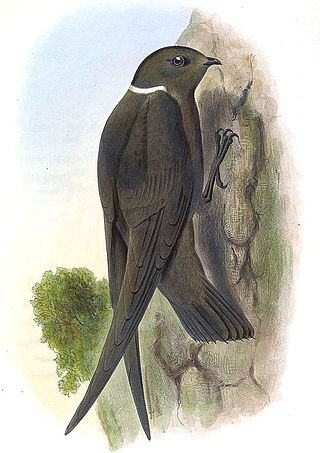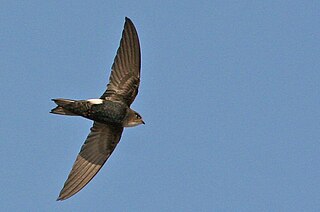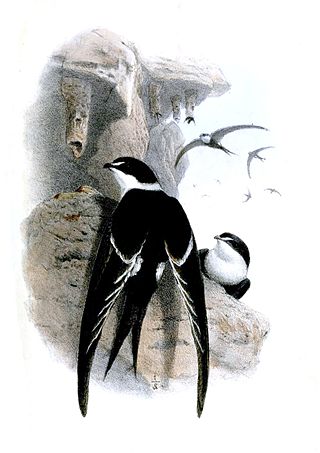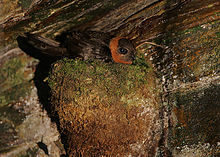
The swifts are a family, Apodidae, of highly aerial birds. They are superficially similar to swallows, but are not closely related to any passerine species. Swifts are placed in the order Apodiformes with hummingbirds. The treeswifts are closely related to the true swifts, but form a separate family, the Hemiprocnidae.

The Pacific swift or fork-tailed swift is a species of bird that is part of the Swift family. It breeds in eastern Asia. It is strongly migratory, spending the northern hemisphere's winter in Southeast Asia and Australia. The general shape and blackish plumage recall its relative, the common swift, from which it is distinguished by a white rump band and heavily marked underparts. The sexes are identical in appearance, although young birds can be identified by pale fringes to the wing feathers that are absent in adults. This swift's main call is a screech typical of its family. It is one of a group of closely related Asian swifts formerly regarded as one species.

The chestnut-collared swift is a species of bird in subfamily Cypseloidinae of the swift family Apodidae. It is found from Mexico and Trinidad south to Peru and Bolivia.

The white-collared swift is a species of bird in the subfamily Cypseloidinae of the swift family Apodidae. It is found in Mexico, the Greater and Lesser Antilles, Trinidad, and every mainland South American country except Uruguay.
A rheophile is an animal that prefers to live in fast-moving water.

The white-naped swift is the largest representative of the swift family in the New World and one of the two largest species in the world. Only the purple needletail of Asia may be slightly larger. This bird is found principally in western and central Mexico, with one record on the Guatemalan border.

The Horus swift is a small bird in the swift family Apodidae that is found in sub-Saharan Africa. Horus, whose name this bird commemorates, was the ancient Egyptian god of the sun, son of Osiris and Isis.

The Andean swift is a species of bird in subfamily Apodinae of the swift family Apodidae. It is found in Argentina, Bolivia, Chile, and Peru.

Aeronautes is a genus of swifts in the family Apodidae.

The great dusky swift is a species of bird in subfamily Cypseloidinae of the swift family Apodidae. It is found in Argentina, Brazil, Paraguay, and possibly Bolivia.

Hirundapus is a genus of swifts in the family Apodidae. The name Hirundapus is constructed from the names of the swallow genus Hirundo and the swift genus Apus.

The great swallow-tailed swift is a species of bird in subfamily Apodinae of the swift family Apodidae. It is found in Costa Rica, Guatemala, Honduras, Mexico, and Nicaragua.

The biscutate swift is a species of bird in subfamily Cypseloidinae of the swift family Apodidae. It is found in Argentina, Bolivia, Brazil, and possibly Paraguay.

The tepui swift is a species of bird in subfamily Cypseloidinae of the swift family Apodidae. It is found in Brazil, Guyana, and Venezuela.

Tachymarptis is a genus of bird in the swift family, Apodidae. It contains the Alpine swift of Eurasia and Africa and the mottled swift of Africa. They are large swifts with relatively broad wings, a large head, a medium-length forked tail and white in the underparts. They are often included in the genus Apus but they are larger than other members of that genus, their nestlings have a different foot structure and they host different species of feather lice. The species placed in Tachymarptis are not deeply nested inside Apus but represent a monophyletic sister lineage to this genus, in order that they can either be regarded as a distinct genus or lumped into a genus Apus with a broader definition. This latter view is the one retained by the Clements Checklist (2022). The name Tachymarptis comes from Greek takhus ("fast") and marptis ("seizer").

Poço das Antas Biological Reserve is a biological reserve located in Rio de Janeiro State, Brazil.

The Cypseloidinae are a subfamily of swifts and contain the following species:
The Malagasy palm swift is a small swift in the family Apodidae. It is very similar to the African palm swift, Cypsiurus parvus, with which it was formerly considered conspecific. It was split based on differences in vocalizations and plumage coloration.
















